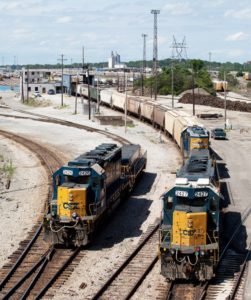Three freight rail stories that may not have received the attention they deserved:
FRA’s new brake rule
The Federal Railroad Administration’s new rule extending the time parked freight cars can be left off air will accelerate operational changes that were already under way on the Class I railroads.

The long-awaited rule, adopted Dec. 11, will permit freight cars to be left off air for 24 hours, up from just four, without requiring a time-consuming full Class I brake test.
This means a couple of trends related to the implementation of Precision Scheduled Railroading — reduced reliance on major terminals and an increased emphasis on block-swapping instead of intermediate switching — are likely to get a boost.
Railroads will be able to make operational changes thanks to the operational flexibility the rule will provide.
In major terminals, air connections are available for parked cuts of cars. But the Class I systems are trying to push switching work out of big yards, especially hump yards, to smaller outlying facilities that typically lack air connections.
A 24-hour air window, instead of four, makes many more locations suitable for block-swapping without the intensive Class I brake test that requires a complete inspection of the train.
Performing a less-intensive Class III brake test typically saves 30 minutes to an hour or more, depending on the length of the train. That’s important for a road train doing work en route, when the hours of service law often comes into play and can require a recrew.
Block swapping — road trains picking up or setting out cuts of cars bound for common destinations — also is more easily accomplished outside of busy major terminals thanks to the new rule. When road trains block swap in hump yards, for example, they may tie up yard leads and disrupt normal switching operations. So shifting this work to satellite locations makes block swapping more efficient.
The rule also opens up more locations, such as passing sidings, to block swaps. A passing train could drop a cut of cars for a following train to pick up, for example, but within 24 hours instead of four. Says one operating official: “A four-hour window is pretty narrow for us to hit.”
Local operations also may be affected. If a local builds westbound and eastbound blocks, for example, the crew could stash a block in a siding for a road train to pick up, rather than put the traffic into a local yard.
Canada has allowed trains to be off air for 24 hours since 2008, and Canada’s operational safety data supports FRA’s action, according to the safety agency.
With this change, FRA estimates the industry will perform 110,000 fewer Class I brake inspections annually.
The change reduces the cost and time needed for inspections while permitting more flexibility to turn off locomotives, which is expected to result in fewer locomotives idling in yards.
The decline of coal
No one projected a reversal of coal’s fortunes in 2020: The year was expected to be just another in the long-term decline of coal.
But then came the pandemic, which accelerated the downturn in the Powder River Basin and Eastern coal fields. Overall U.S. coal volume in 2020, through Dec. 19, was down 25% compared to 2019, according to the Association of American Railroads. That is a staggering year-over-year decline.
The pandemic reduced demand for electricity while natural gas — the favored fuel for electricity generation — remained at record or near record low prices, making coal even less competitive.
The coal story, however, was overshadowed by the broad declines in nearly every single rail-hauled commodity due to the impact of the pandemic.
Canadian National’s bad start to the year
Does anyone remember what happened in 2020 before the pandemic hit in March? It seems like a long time ago, but Canadian National had a start to the year it would rather forget.

CN suffered through a string of events that was odd, unrelated, and unrelenting. Through the end of February, CN’s volume was down 16% due to a combination of bad weather, civil protests, and a regulatory order that slowed trains carrying hazardous materials.
Mother Nature started with an eight-day cold snap that restricted train lengths in Western Canada. Then powerful rainstorms lashed southern British Columbia starting Jan. 30, washing out CN’s main to Vancouver for six days. The major washouts occurred in the rugged Fraser River canyon directional running zone where CN and Canadian Pacific share trackage, with CN hosting westbounds and CP carrying eastbounds. The railways had to resort to running directional fleets of 15 to 20 trains at a time over CP’s line. The single-track bottleneck caused eastbound traffic to stack up at the Port of Vancouver and westbounds to be staged as far away as the Prairies. The directional-running zone ranks among the top three freight mains by tonnage in North America, so this blockage was, by itself, a big deal.
Then came nearly a month of civil protests. On Feb. 6, as CN began digging out from the washout backlog, the first of several First Nations blockades set up camp on CN’s tracks. The blockades, protesting a proposed natural gas pipeline in British Columbia, halted traffic on CN’s Montreal-Toronto mainline in the East. Also ultimately affected: CN’s line to Prince Rupert, British Columbia, blocked by protests for six days. Other protests came and went in Edmonton, Alberta; Winnipeg, Manitoba; Quebec; and British Columbia. CP was affected, too, but to a much lesser extent. CP even hosted detour traffic for CN between Montreal and Toronto.
Then came regulatory woes. The day the protests began, a CP crude oil train derailed and caught fire in Guernsey, Saskatchewan, the second such wreck in the area since December. Hours later Transport Canada issued a ministerial order that restricted key trains — those with 20 or more cars of hazardous materials — to 20 mph in metropolitan areas and 25 mph elsewhere. These speed limits effectively reduced CN’s overall capacity by a third. CN’s average train speed, which began the year at a healthy 20.3 mph, sank 23% to 15.9 mph. And car-miles per day, an all-in metric that’s the result of train speed and terminal dwell, fell 40%, to 136 miles from 228 in the first week of January.
On Feb. 16, Transport Canada modified its order, permitting key trains to operate at 50 mph in signalled territory and 30 to 35 mph in metropolitan areas ,depending on the commodity and volume carried per train. CN immediately began bouncing back, and on-dock container volume at Vancouver has quickly returned to normal levels.
Meanwhile, CN on Feb. 13 was forced to shut down its network in Eastern Canada due to the ongoing First Nations protests. Some 400 trains had been cancelled over the prior week, a number that does not include the suspension of virtually all VIA Rail passenger service from coast to coast. CN furloughed 450 or so people in the East as a result of the illegal blockades. On March 1 the federal government reached a tentative deal with the Wet’suwet’en Hereditary Chiefs to end the protests.













